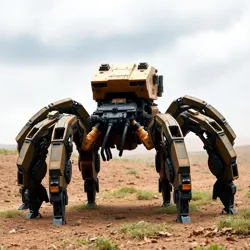Tarantula Heavy Assault Units
 A Mark IV Tarantula Heavy Assault Unit demonstrating its characteristic intimidation pose during field exercises
A Mark IV Tarantula Heavy Assault Unit demonstrating its characteristic intimidation pose during field exercisesTarantula Heavy Assault Units (THAUs) are advanced biomechanical warfare platforms developed in 2168 as a response to the increasing need for versatile heavy combat units. These massive synthetic arachnids combine overwhelming firepower with sophisticated terrain adaptation capabilities and represent the pinnacle of ground-based synthetic combat evolution.
Design and Capabilities
Standing at 3.5 meters tall with a leg span of 6 meters, THAUs feature a revolutionary quantum-reinforced exoskeleton capable of withstanding direct hits from conventional weapons. Their eight legs are equipped with adaptive terrain-gripping mechanisms and integrated weapon systems, allowing for simultaneous movement and combat operations.
Primary Systems
- Plasma Web Projectors for area denial
- Multi-directional heavy weapon mounts
- Advanced sensor arrays
- Nano-repair colonies
- Quantum targeting systems
Combat Applications
THAUs excel in various combat scenarios: - Urban warfare operations - Heavy assault missions - Fortification breaching - Area denial operations - Support for Mantis Strike Teams
Tactical Integration
The units typically operate in pairs called "Clutches," with each THAU specializing in complementary combat roles. Their neural synchronization systems allow for seamless tactical coordination and shared targeting data.
Development History
Originally conceived by Arachnid Warfare Systems, THAUs underwent extensive field testing before their first combat deployment during the Neo Shanghai Incident. Their success led to widespread adoption by military forces worldwide.
Technical Specifications
- Height: 3.5 meters
- Leg Span: 6 meters
- Weight: 2,800 kg
- Operating Range: 800 kilometers
- Power Source: Dual Thoracic Fusion Cores
- Maximum Speed: 70 km/h
See Also
- Spider Infiltration Units
- Heavy Combat Platforms
- Synthetic Ground Forces
References
- Advanced Combat Systems Review
- Synthetic Warfare Quarterly
- Biomechanical Combat Engineering Digest